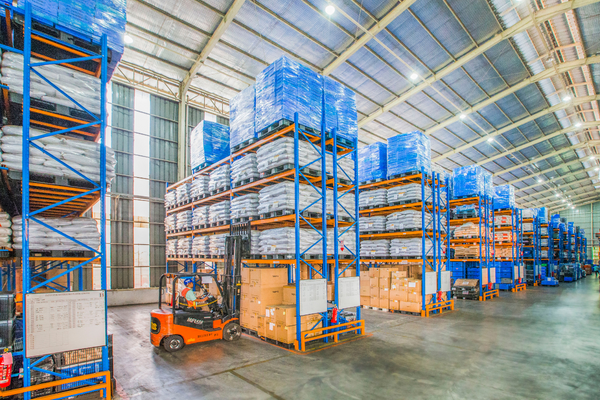Need A New App?
We build your dream app from conception to completion!
Leave Your Details and We’ll Get Back to You!
Playback speed:

Running a successful warehouse that meets customer needs and expectations can be a daunting challenge. The warehouse must have the right people, processes, and technology in place to ensure that everything runs smoothly. One key piece of technology is a warehouse management system (WMS). A WMS is a set of software applications that help warehouses manage their operations more efficiently. In this article, we will explore the cost benefits of a warehouse management system and how to calculate the return on investment (ROI) of implementing one. We will also look at the cost of not having a WMS, best practices for maximizing ROI, different types of WMS, the benefits of automation, and the advantages of cloud-based WMS.

A warehouse management system (WMS) is a set of software applications that help warehouses manage their operations more efficiently. It is designed to help warehouses track inventory, manage orders, and optimize the movement of goods within the warehouse. WMS also helps warehouses improve customer service by providing real-time data on inventory levels and order status.
It helps streamline operations by providing real-time visibility into warehouse inventory, automating processes, and improving operational efficiency. WMS software helps businesses manage their warehouses by optimizing productivity, accuracy, and safety. It also helps to reduce costs associated with labor, space, and inventory.
If you are still asking yourself why to have a warehouse management system, then these benefits would definitely change your mind. The primary benefit of a WMS is increased efficiency. By automating processes such as order picking, packing, and shipping, a WMS can reduce the amount of time it takes to fulfill an order. This can result in faster delivery times, improved customer service, and cost savings.
The primary benefit of a WMS is increased efficiency. By automating processes such as order picking, packing, and shipping, a WMS can reduce the amount of time it takes to fulfill an order. This can result in faster delivery times, improved customer service, and cost savings.
A WMS can also help improve inventory accuracy. With a WMS, inventory levels can be monitored in real time and discrepancies can be quickly identified and addressed. This can help warehouses reduce the amount of stock they need to keep on hand, resulting in cost savings.Finally, a WMS can help warehouses increase visibility and control. By providing real-time data on inventory levels, order status, and other important metrics, a WMS can help warehouses better understand their operations and make more informed decisions.
A warehouse management system can provide a number of cost benefits for warehouses, including cost savings from improved efficiency, improved inventory accuracy, and increased visibility and control.
Improved efficiency can lead to cost savings in a number of ways. For example, by reducing the amount of time it takes to fulfill an order, a WMS can help warehouses reduce labor costs. Additionally, a WMS can help reduce the amount of time it takes to find and retrieve items, reducing the amount of time it takes to replenish stock and resulting in fewer items being left on the shelves.
Improved inventory accuracy can also lead to cost savings. By reducing the amount of stock that needs to be kept on hand, warehouses can reduce storage costs and free up valuable space for more profitable uses. Additionally, by reducing the number of stockouts, a WMS can help warehouses reduce lost sales and save money on replacements.
Finally, increased visibility and control can help warehouses save money by providing the data needed to make informed decisions. By understanding the warehouse’s operations better, warehouses can identify areas of inefficiency or unnecessary expenditure and make the necessary changes to reduce costs.
Therefore, with whopping benefits, you are saving lots of money with this strategy

Calculating the return on investment (ROI) of a warehouse management system is an important step in deciding whether or not to invest in one. The ROI calculation is used to determine the amount of money a warehouse will save or earn by implementing a WMS.
To calculate the ROI of a WMS, you need to first identify the costs associated with the WMS and the expected benefits. The costs typically include the purchase price, implementation costs, maintenance fees, and labor costs. The benefits can include cost savings from improved efficiency, improved inventory accuracy, and increased visibility and control.
Once you have identified the costs and benefits, you can calculate the ROI. The formula for calculating the ROI is:
ROI = (Benefits – Costs) / Costs
For example, if a warehouse spends $10,000 on a WMS and is able to save $1,500 a year in labor costs, the ROI can be calculated as:
ROI = ($1,500 – $10,000) / $10,000
ROI = -0.9
This means that the warehouse will not see a return on its investment until the tenth year of using the WMS.
One of the most important benefits of a warehouse management system is improved efficiency. Without a WMS, warehouses may be unable to keep up with customer demand, resulting in lost sales and dissatisfied customers. Additionally, without a WMS, warehouses may have difficulty managing their inventory, resulting in stockouts and wasted resources.
In addition to lost sales and wasted resources, not having a WMS can also lead to increased labor costs. Without a WMS, warehouses may need to hire additional staff to handle the increased workload. Additionally, without the increased efficiency of a WMS, warehouses may need to increase staff overtime hours, resulting in higher labor costs.
Finally, not having a WMS can lead to increased storage costs. Without a WMS, warehouses may need to keep more stock on hand to meet customer demand, resulting in higher storage costs.
Once you have implemented a warehouse management system, there are a number of best practices that can help you maximize the ROI of the system. First, it is important to ensure that your employees are trained on the system. A WMS can only be as effective as the people using it, so it is important to make sure that your employees are familiar with the system and know how to use it effectively.
Second, it is important to make sure that the system is properly integrated with other systems, such as your accounting system, order management system, and customer relationship management (CRM) system. This will ensure that the data in these systems is accurate and up-to-date. Another important thing to monitor is the performance of the system. By monitoring the system, you can identify areas of inefficiency or unnecessary expenditure and make the necessary changes to reduce costs.
Finally, it is important to take advantage of new features and technologies. WMS technology is constantly evolving, so it is important to stay up-to-date on the latest features and technologies to ensure that you are getting the most out of your system.
There are four main types of Warehouse Management Systems (WMS): standalone, as a module in supply chain management (SCM) software, as a module within an ERP system, and delivered as a cloud-based system. Standalone WMS focuses on warehouse operations and offers features that enable efficient day-to-day warehouse operations. Enterprise Resource Planning (ERP) software integrates the warehouse management system with other areas of the business. Cloud-based WMS delivers the software through the internet and offers increased scalability. Finally, Supply Chain Module WMS is used for companies with complex supply chains and integrates warehousing with the wider supply chain system.
The most common types of WMS are on-premise systems and cloud-based systems. On-premise systems are installed on a warehouse’s local server and are managed by the warehouse’s IT staff. Cloud-based systems, on the other hand, are managed by a third-party provider and are accessed via the internet.
Additionally, some WMSs are designed to manage specific types of operations, such as order fulfillment, inventory management, or supply chain management. Other WMSs are designed to manage multiple types of operations and can be customized to meet the needs of a specific warehouse.
Automation is one of the most important features of a warehouse management system. Automation can help warehouses increase their efficiency and reduce their costs.
By automating processes such as order picking, packing, and shipping, a WMS can reduce the amount of time it takes to fulfill an order. This can result in faster delivery times, improved customer service, and cost savings.
Automation can also help warehouses reduce labor costs. By automating processes, warehouses can reduce the amount of time and manpower needed to complete tasks. This can help warehouses reduce the number of employees they need to hire and the number of hours they need to pay for.
Finally, automation can help warehouses reduce the amount of errors in their operations. By automating processes, warehouses can reduce the chance of errors, resulting in fewer stockouts and fewer returns. This can help warehouses save money on replacements and improve customer satisfaction.
Related Article you may also like to read
Loan Management System
A warehouse management system (WMS) is a set of software applications that help warehouses manage their operations more efficiently. It is designed to help warehouses track inventory, manage orders, and optimize the movement of goods within the warehouse.
The primary benefits of a WMS are increased efficiency, improved inventory accuracy, and increased visibility and control.
To calculate the ROI of a WMS, you need to first identify the costs associated with the WMS and the expected benefits. The costs typically include the purchase price, implementation costs, maintenance fees, and labor costs. The benefits can include cost savings from improved efficiency, improved inventory accuracy, and increased visibility and control. Once you have identified the costs and benefits, you can calculate the ROI using the formula: ROI = (Benefits – Costs) / Costs.
The most common types of WMS are on-premise systems and cloud-based systems. On-premise systems are installed on a warehouse’s local server and are managed by the warehouse’s IT staff. Cloud-based systems, on the other hand, are managed by a third-party provider and are accessed via the internet. Additionally, some WMSs are designed to manage specific types of operations, such as order fulfillment, inventory management, or supply chain management. Other WMSs are designed to manage multiple types of operations and can be customized to meet the needs of a specific warehouse.
A warehouse management system (WMS) can provide a number of cost benefits for warehouses, including cost savings from improved efficiency, improved inventory accuracy, and increased visibility and control. To maximize the ROI of a WMS, it is important to ensure that your employees are trained on the system, ensure that the system is properly integrated with other systems, monitor the performance of the system regularly, and take advantage of new features and technologies. Additionally, it is important to understand the different types of WMSs available and the benefits of automation and cloud-based WMSs.
Overall, a warehouse management system can help warehouses save money and improve customer service. By understanding the cost benefits of a WMS and how to calculate the ROI of one, warehouses can make informed decisions about their technology investments and maximize their ROI
We build your dream app from conception to completion!
Leave Your Details and We’ll Get Back to You!
